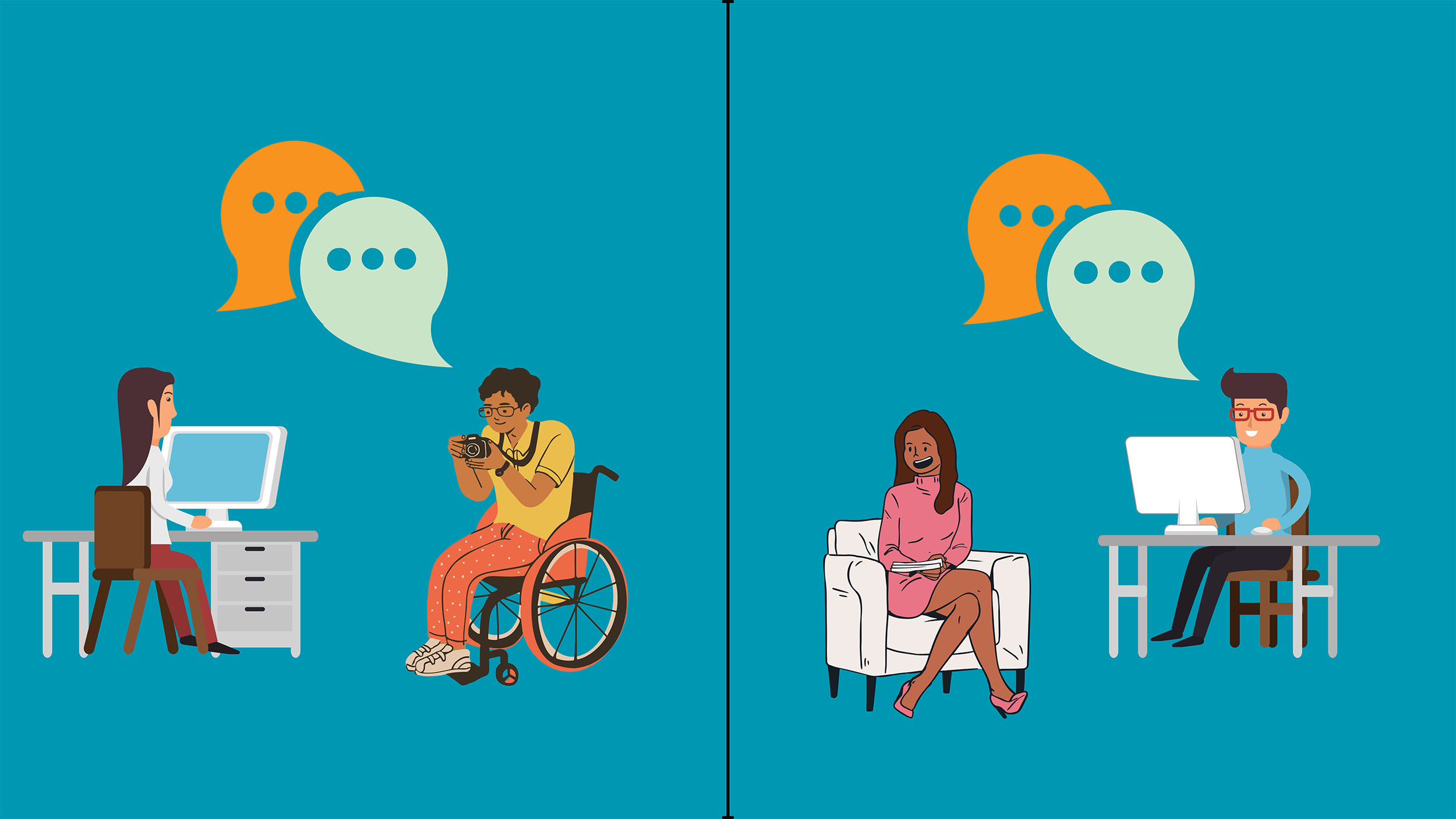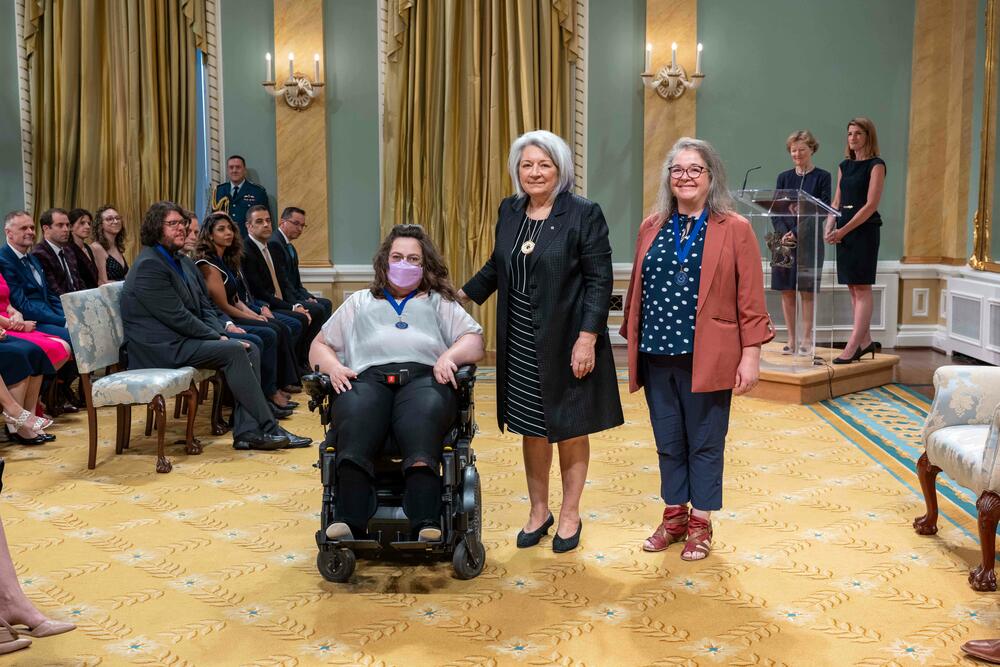Dialogue on disability

caption
Advocating for accessibility in the newsroom
This story is accessible: Listen to author Sarah Drysdale read this article.
Sarah Trick waits for the taxi that’s supposed to take her to the Michener Awards ceremony. The wrong transport has been sent, and not only is it not a wheelchair cab, but she can’t access the vehicle with her power chair. Feeling like there is no alternative, she makes her way down Ottawa’s Sussex Drive.
She was supposed to be at the ceremony an hour before it started, but instead, she is now almost late for a ceremony where she will receive a fellowship.
“The thing that is incredibly hard for able-bodied people to wrap their heads around, is the sheer amount of time that things take, and not only the time it takes to get there, but the time required for planning anything at all,” says Trick.
Trick, a journalist, is an assistant editor with TV Ontario. When talking to colleagues about her routine as a person with a physical disability, Trick says they tend to find it extraordinary. Things like arranging transport and planning when to leave in order to arrive on time are things that able-bodied people don’t have to think about.
Planning the day step-by-step is normal for Trick, who says that’s just her life. “There’s just kind of a disconnect there,” says Trick.
The 2023 Michener Fellowship Trick shared with educator Alanna King was awarded to support the creation of a style guide to help journalists cover disability in a more thoughtful and nuanced fashion.
Trick and King received the Michener- Richard O’Hagan Fellowship for Journalism Education in June. The award provides them with a $40,000 grant, allowing them to produce the style guide.
Trick says the guide is needed because it’s embedded in people’s brains to fall back on what’s familiar, and the most familiar thing in disability reporting are the clichés that come along with it. The result is an abundance of tropes found in disability reporting. It’s common for stories on disability to be about overcoming a challenge or barrier. The impression is that everything a person with a disability does is inspirational.
“Any well intentioned reporter might know all of this and want to do the best that they can,” Trick says. “But then they have to file in an hour and what comes out of their keyboard? ‘So-and-so is so inspirational for doing this thing that doesn’t have anything to do with their disability, said their ninth-grade English teacher.’ ”
For disabled journalists, an accommodating workplace is fundamental. In order for it to work, two things are required: An employer willing to communicate clearly and compassionately, and a journalist who is willing to share their ideas of what can help them do their job more comfortably.

caption
Her Excellency the Right Honourable Mary Simon, Governor General of Canada, presented the 2021 and 2022 Michener Awards for meritorious public service journalism, as well as the 2022 and 2023 Michener-Deacon Investigative Fellowship and Michener-L. Richard O’Hagan Educational Fellowship, at a ceremony that was held at Rideau Hall on June 16, 2023.Accommodations in the workplace
Michelle McQuigge, a weekends and special projects manager at Canadian Press, is visually impaired. She says her employer provided the specialized software she needed to be able to do her job.
“They have to create a space where people with disabilities feel comfortable disclosing their disabilities,” McQuigge says. “Without those conversations, you can’t really make much headway.”
Dave Brown, a visually impaired journalist who works for Accessible Media Inc., says that throughout his career, he has had a positive experience receiving accommodations from employers.
Brown says that having several internships throughout his career was helpful for him, but this isn’t always the case for disabled journalists who want to progress in their career beyond the entry level.
Trick says that not being able to advance in the workplace is an unfair hurdle many minority and disabled journalists face.
“There’s no way to progress up the ladder, so you don’t get (disabled) people in supervisor roles or manager roles, and so culture doesn’t change because it’s going from the bottom up,” Trick says. “You might have years of experience but you might not ever get that progressively more responsible role, and that means that HR people won’t be looking at you when they’re looking to fill those roles.”
Learning your advocacy language
For journalists with non-visible disabilities, this can be a trickier line to walk. In some instances, those with visible disabilities may find it easier to discuss accommodations than someone with a disability that isn’t visible. For both visible and invisible disabilities, self-advocacy is essential.
Brown says that you have to learn to advocate, and a way to do this is to “learn your advocacy language.” This means being able to describe your disability, and becoming comfortable with that expression.
“Obviously we want a world that’s more inclusive and accessible, that’s the ultimate goal, but in the meantime we can’t sit around waiting for it,” says Brown.
“It’s about doing that work internally to understand how you want to advocate and the language you want to use and your own techniques,” Brown says. “That can only come with practice.”
Inclusion from your employer
Trick says disabled journalists are sometimes excluded because they might need to do things differently than able-bodied journalists.
Employers can provide more accessible equipment for journalists with disabilities. A small gesture like this can be a perfect fix, and also allows people to still do their job, just with a modification.
“There could be more creativity and thinking,” Trick says.
Aaron Broverman, the lead editor for Forbes Advisor Canada, has cerebral palsy. He says that in the workplace it’s crucial to ask questions of the employer or, even better, during job interviews. This helps employers understand their disability, and also helps ensure they’re comfortable in their position.
“You have to sort of ask weirdly annoying questions so that you don’t put yourself in a situation that you didn’t want to be in in the first place,” he says. “You kinda have to be that person, and if they don’t wanna work with that person, then fine, you have to find some other situation.”
Journalists with disabilities can find these discussions during the interview phase to be either very helpful, or the exact opposite. Broverman says that if employers aren’t willing to understand, then it shows what they do and do not value in the workplace.
“That would be your answer. You probably don’t want to work with them anyway,” Broverman says. “You want to work for a place that welcomes you, and is happy that you’re asking these questions and actually wants to find answers for you.”
People with disabilities may not be hired as much as their able-bodied peers, according to a study by a Canadian research team published in the Journal of Business and Psychology in 2019. It says that the employment rate among working-age Canadians living with a disability is 49 per cent, while it is 79 per cent for those without a disability.
One reason disabled people may not be hired as much as able-bodied people, the article suggests employers are skeptical about whether or not journalists with disabilities are able to keep up expectations of the job.
Broverman says that hustle culture has taken away compassion in a lot of jobs. However, it’s not impossible to find an accommodating workplace. “There’s still jobs out there that treat people like human beings.” Broverman says. “I know because I have one.”
Reevaluating and Readjusting
Brown says that employers should come to these conversations with an understanding of what makes a workplace accessible and equitable.
“I think there needs to be just a flat-out baseline understanding of what it means to be inclusive towards people with disabilities, just like you would be any other marginalized person whether that be racially, religious, et cetera,” says Brown.
Brown also says that employers can show their understanding of inclusivity through universal design and accessibility in the workplace. Things such as software, physical space and sensitivity training help to make sure everyone is on the same page when it comes to accessibility and understanding.
It’s important to understand however, that accommodations are not always one-size-fits all. “It’s a very fluid spectrum kind of concept,” says Brown. Individuals need their own accommodations, and they may not know exactly what they need on day one of the job.
“There needs to be this understanding of the spectrum and the reevaluation and the readjustment as time moves forward,” Brown says.
With minutes to spare, Trick makes it to Rideau Hall before the event starts, and finds her seat next to King in the front row. Their award is announced, and she makes her way to the front of the hall as Margo Goodhand of the Michener Awards Foundation explains the disability style guide and the benefits it will have for journalism. Gov. Gen. Mary Simon meets her in the middle of the yellow carpet, and places a medal around her neck before they pose for pictures together.
This is just a day in her life.
About the author
Sarah Drysdale
Sarah is originally from Bedford, N.S. She's in her fourth year of the BJH program.
